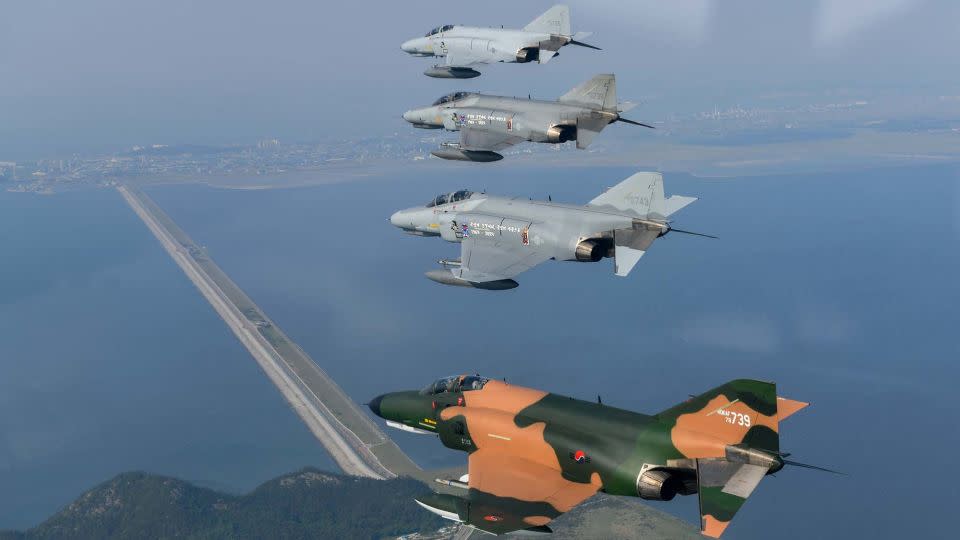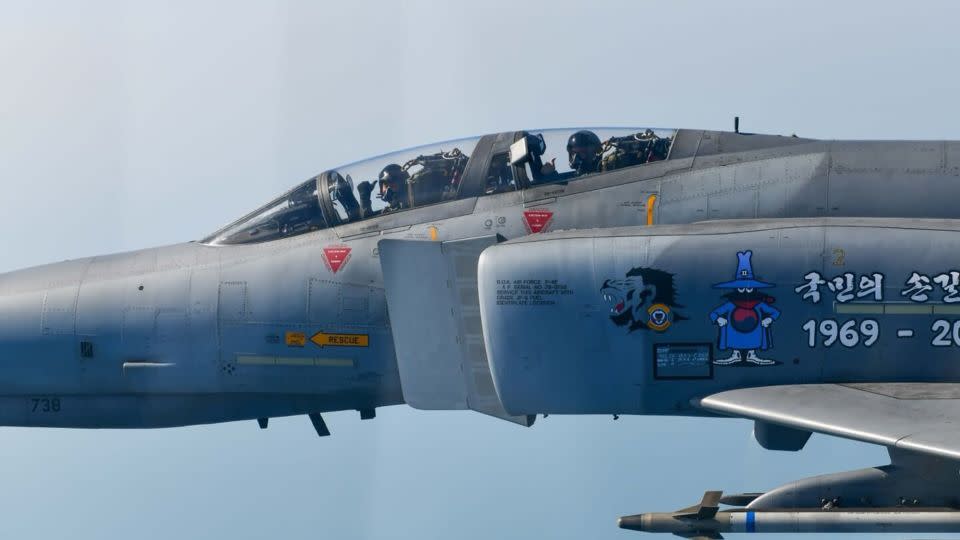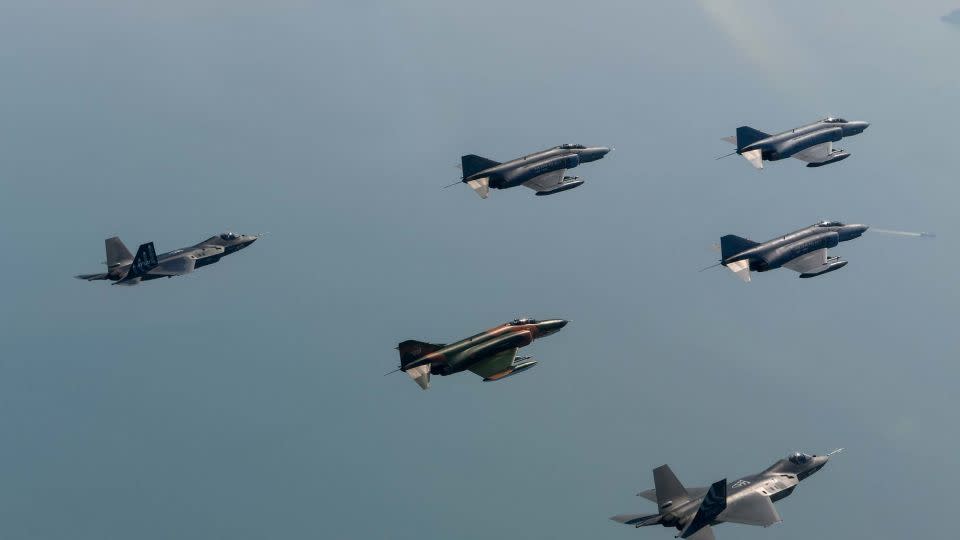‘My vision went dark’: CNN reporter experiences 6G-force before hitching a fighter jet ride
It took more than 40 years, but I finally lived my “Top Gun” dream.
For an hour and 40 minutes, in the back seat of a South Korean Air Force F-4 Phantom, I was “Goose” from the classic 1980s movie – and it was so worth the wait.
As a kid, I loved newspapers and writing, so journalism was a natural choice for a career.
But I also loved military stuff – especially military aviation – and nothing exemplified that better than the stories of US Navy aviators in the Battle of Midway, where the US turned the tide against Japan in World War II by sinking four of its aircraft carriers.
After receiving my journalism degree in 1981, I thought I could still try flying for the military. So I went to see a Navy recruiter and took the physical. Part of that was a colorblindness test. There were pinpricks of light across a dark room, and I had to say which were red and which were green.
I failed miserably, an automatic disqualifier for a modern pilot.
So it was off to the civilian working world, the pilot dream shattered – until a few months ago, when the South Korean Air Force said a CNN representative could take part in a farewell flight of its F-4 Phantom fleet.

Memories of the Phantom
If there were a perfect match for me to make my fighter dream come true, it had to be the Phantom.
It first flew in 1958, a year before I was born, and was truly the military aircraft of my youth, appearing almost nightly on the news as the workhorse of the US air fleet in the Vietnam War. In the late 1960s to early 1970s, it was the plane the US Navy Blue Angels and US Air Force Thunderbirds flight demonstration teams flew when they appeared at my hometown Cleveland National Air Show.
In 1969, US ally South Korea acquired the McDonnell-Douglas-made jets, as it fortified its air forces against possible aggression from North Korea.
From their base in Suwon, just south of the capital Seoul, the supersonic F-4s could reach the demilitarized zone in five minutes or less. And considering an F-4 could perform air-to-air combat and carry a bomb load double that of a World War II B-17 bomber, it was quite a boost for South Korea’s military.
The fact that F-4s are still in service more than 60 years after the model’s first flight says something about the jet’s durability too.
The US military last flew the F-4 in 1996. Besides South Korea, only Greece, Turkey and Iran still have the Phantom in service.
Oh, no! Another physical test
Finally getting that F-4 ride was not going to be as easy as hopping on Korea’s KTX bullet train and making the 90-minute trip to Daegu from Seoul, however.
Nope, I’d have to demonstrate some physical abilities – being able to withstand low air pressure, being able to handle an aircraft ejection, avoiding vertigo in a simulator, and, most importantly, being able to withstand 6Gs – six times the force of gravity – on my body in a centrifuge simulator.
I was warned just under half of those testing would pass out under the 6G force.
That test would come a few weeks before the F-4 flight at a South Korean Air Force medical facility south of Seoul.
After being outfitted with a flight suit and boots, I made my way to the 6G simulator along with other reporters being tested as candidates for the trip.
We were quickly taught breathing techniques and how to tense our bodies to prevent the blood from slipping from our brains.
Unknown to me before the test, the flight surgeons didn’t think my body had “the right stuff.” A bit chubby, poor posture, and he’s 65, they told my colleagues.
But I’m an Ohio boy, from the home of the Wright Brothers – “birthplace of aviation” it says on our license plates. It’s also the birthplace of astronauts like Neil Armstrong and John Glenn, the latter of whom flew the space shuttle at age 77.
With that pedigree, I was confident I’d make it.
I’d get two chances to withstand 6Gs. Keep it together and don’t pass out in 20 seconds.
I climbed into the simulator, gave a thumbs up and … holy hell.
Hitting 6Gs, my vision went dark. I saw only pink spots on a black background. I sucked in quick bursts of air, let out some guttural shrieks. Seeing a video of my test later, I realized I looked like I was undergoing an exorcism.
But I didn’t pass out – and that was good enough.
Take me to your F-4
My Phantom flight was the second of a two-leg commemorative flight set up by the South Korean Air Force to mark the retirement of the aircraft. As of June 7, their service time is done.
During each leg, there would be four F-4s flying in formation – three carrying journalists in the back seat – with an F-15, which would carry a photographer to record the events.
As our military bus pulled into Daegu Air Base on a sunny Thursday afternoon, the morning flight – from Suwon to Daegu – screamed over the runway. I got a tingle and a smile.
This was real. And I was ready.

I greeted a US journalist on the morning flight as she climbed down from the F-4 I’d fly in the afternoon.
“How was it?”
Good for me, she said, but not so for the Korean reporters in two of the other jets. Both had been nauseous. One vomited – twice.
After lunch and a flight briefing with the pilots, it was time to kit up and head to the aircraft for the afternoon flight.
Once back on the tarmac, things went as fast as the F-4 itself. Preparations became a blur. I’m pretty sure I high-fived my pilot at some point – “I feel the need, the need for speed” – then climbed the ladder to the cockpit, hooked up and strapped in and the pilot spooled up the General Electric J79 turbojet engines.
Then I got to do real back-seater work. I turned the radar on. It could only be done from the back seat. Yes, I am Goose.
We closed our separate canopies, taxied out to the runway and roared into the Korean blue yonder.
History, and future, at 4,000 feet
As we reached cruising altitude, our formation closed up – the big fighter-bombers getting almost wing tip to wing tip.
The pilot made throttle adjustments to keep up and keep spacing, providing a smooth but a bit jerky ride. I knew now where my Korean colleagues got their stomach challenges.
After 10 to 15 minutes, I looked down and back and to my right. Tucking nicely to our formation was the future of South Korean military aviation, the homegrown KF-21 fighter, a prototype and one of only six yet to take to the skies. A second KF-21 pulled up to the left of the formation.

Korea Aerospace Industries, the builder of the KF-21, has made a fleet of six prototypes, which are undergoing test flights until 2026, when mass production and deployment will begin. A total of 120 are expected to be delivered to the South Korean Air Force by 2030, and the jet is expected to be exportable.
After 15 to 20 minutes with the formation, the KF-21s turned sharply away, their wings almost perpendicular to the ground, and returned to base.
The Phantoms flew on.
As I marveled at the KF-21, I marveled too at the jet I was sitting in. I stenciled in my mind images of the knobs and buttons and levers on three sides of me.
This analog wonder spoke to me, to my time, my generation.
Those KF-21s are digital wonders, a different type of flying.
One Korean Phantom pilot told me he wouldn’t be transitioning to the KF-21. He’d fly the equivalent of a Boeing 737. Others might go to less sophisticated fighters in the Korean fleet or even become drone pilots. One said, with more than a bit of melancholy, he’d be flying a desk. No one they knew would be flying the KF-21.
The last leg
As we flew over the Yellow Sea and up the west coast of the Korean Peninsula, I looked at the analog clock on the instrument panel in front of me.
“I’ll be damned. It’s 10 minutes slow,” I think, confirming my assessment with the Casio strapped to my wrist.
Somehow appropriate, but nevertheless disappointing. Now this adventure was going to end sooner than I’d realized.
Soon, the pilot banked the Phantom to the right, radio chatter picked up with instructions, and we began our approach to Suwon Air Base.
The analog gauges on the lower left of my instrument panel showed flaps deployed as the pilot slowed the Phantom and then the tricylce landing gear lowering.
We banked hard left and hard left again to get on final approach as I looked almost straight down on the Suwon landscape.
In seconds, the wheels made contact with concrete, smoother than you’d feel on a passenger jet. To my surprise, no jolt, no vibration as the 30,000-pound warplane rolled out on the runway.
As ground crew checked the four planes before we taxied to the hangars, the pilot asked my thoughts.
“I’ll run to get in the front of the line again,” I said, my mind thinking back to Ohio, and sprinting among the stanchions to get back to the front of the line for another ride on the rollercoaster at Cedar Point amusement park.
I have a laminated paper card in my wallet, my “Aerospace Physiological Training Certificate,” authorizing me to fly on South Korean fighter jets until June 30, 2025. That’s the proof I passed that 6G test.
Nah, don’t even think about it, wouldn’t be the same.
For an hour and 40 minutes, I was “Goose.” For an hour and 40 minutes, I lived my four-decade dream.
For more CNN news and newsletters create an account at CNN.com

